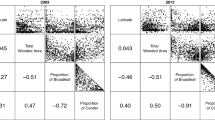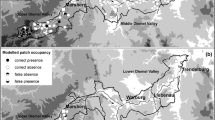Abstract
Little information is available regarding the landscape ecology of woodland invertebrate species with limited dispersal ability. An investigation was therefore conducted within woodland fragments in an agricultural landscape for the flightless wood cricket (Nemobius sylvestris) on the Isle of Wight, UK. The current pattern of distribution of the species, established during a field survey, was related to measures of habitat availability and habitat isolation/fragmentation. Results revealed that wood cricket populations were patchily distributed and mainly found in relatively large mature woodland fragments situated closely (<50 m) to another occupied site. Although the occurrence of wood cricket was related to fragment area, isolation, habitat availability and woodland age, a logistic regression model revealed that presence of the species was most accurately predicted by fragment isolation and area alone. These results highlight the vulnerability of relatively immobile woodland invertebrate species, such as wood cricket, to the impacts of habitat loss and fragmentation.





Similar content being viewed by others
References
Andrén H (1994) Effects of habitat fragmentation on birds and mammals in landscapes with different proportions of suitable habitat: a review. Oikos 71(3):355–366. doi:10.2307/3545823
Bailey S (2007) Increasing connectivity in fragmented landscapes: an investigation of evidence for biodiversity gain in woodlands. For Ecol Manage 238(1–3):7–23. doi:10.1016/j.foreco.2006.09.049
Barbaro L, Pontcharraud L, Vetillard F et al (2005) Comparative responses of bird, carabid, and spider assemblages to stand and landscape diversity in maritime pine plantation forests. Ecoscience 12(1):110–121. doi:10.2980/i1195-6860-12-1-110.1
Bellamy PE, Hinsley SA, Newton I (1996) Local extinctions and recolonisations of Passerine bird populations in small woods. Oecologia 108(1):64–71. doi:10.1007/BF00333215
Bennett AF (1999, 2003) Linkages in the landscape: the role of corridors and connectivity in wildlife conservation. IUCN, Gland, Switzerland and Cambridge, UK, pp xiv + 254
Buse J, Schroder B, Assmann T (2007) Modelling habitat and spatial distribution of an endangered longhorn beetle: a case study for saproxylic insect conservation. Biol Conserv 137(3):372–381. doi:10.1016/j.biocon.2007.02.025
Calabrese JM, Fagan WF (2004) A comparison-shopper’s guide to connectivity metrics. Front Ecol Environ 2(10):529–536
Chardon J, Adriaensen F, Matthysen E (2003) Incorporating landscape elements into a connectivity measure: a case study for the speckled wood butterfly (Pararge aegeria L.). Landscape Ecol 18(6):561–573. doi:10.1023/A:1026062530600
Crooks KR, Sanjayan M (eds) (2006) Connectivity conservation. Cambridge University Press, Cambridge, UK
Debuse V, King J, House A (2007) Effect of fragmentation, habitat loss and within-patch habitat characteristics on ant assemblages in semi-arid woodlands of eastern Australia. Landscape Ecol 22(5):731–745. doi:10.1007/s10980-006-9068-0
Drechsler M, Frank K, Hanski I et al (2003) Ranking metapopulation extinction risk: from patterns in data to conservation management decisions. Ecol Appl 13(4):990–998. doi:10.1890/1051-0761(2003)13[990:RMERFP]2.0.CO;2
Driscoll DA (2005) Is the matrix a sea? Habitat specificity in a naturally fragmented landscape. Ecol Entomol 30(1):8–16. doi:10.1111/j.0307-6946.2005.00666.x
Ewers RM, Didham RK (2006) Confounding factors in the detection of species responses to habitat fragmentation. Biol Rev Camb Philos Soc 81:117–142. doi:10.1017/S1464793105006949
Fahrig L (2003) Effects of habitat fragmentation on biodiversity. Annu Rev Ecol Evol Syst 34(1):487–515. doi:10.1146/annurev.ecolsys.34.011802.132419
Fahrig L, Jonsen I (1998) Effect of habitat patch characteristics on abundance and diversity of insects in an agricultural landscape. Ecosystems 1(2):197–205. doi:10.1007/s100219900015 N Y, Print
FitzGibbon S, Putland D, Goldizen A (2007) The importance of functional connectivity in the conservation of a ground-dwelling mammal in an urban Australian landscape. Landscape Ecol 22(10):1513–1525. doi:10.1007/s10980-007-9139-x
Forman RTT, Godron M (1986) Landscape ecology. Wiley, New York, USA
Gabbutt PD (1959) The bionomics of the wood cricket, Nemobius sylvestris (Orthoptera: Gryllidae). J Anim Ecol 28(1):15–42. doi:10.2307/2011
Hanski I (1998) Metapopulation dynamics. Nature 396(6706):41–49. doi:10.1038/23876
Hanski I (1999) Metapopulation ecology. Oxford University Press, Oxford, UK
Hanski I (2004) Metapopulation theory, its use and misuse. Basic Appl Ecol 5:225–229. doi:10.1016/j.baae.2004.03.002
Hanski IA, Gilpin ME (eds) (1997) Metapopulation biology. Ecology, genetics and evolution. Academic Press, New York, USA
Harrison S (1994) Metapopulations and conservation. In: Edwards PJ et al (eds) Large-scale ecology and conservation biology. Blackwell Scientific, Oxford, UK, pp 111–128
Harrison S, Taylor AD (1997) Empirical evidence for metapopulation dynamics. In: Hanski IA, Gilpin ME (eds) Metapopulation biology. Ecology, genetics and evolution. Academic Press, New York, USA, pp 27–42
Herrando S, Brotons L (2002) Forest bird diversity in Mediterranean areas affected by wildfires: a multi-scale approach. Ecography 25(2):161–172. doi:10.1034/j.1600-0587.2002.250204.x
Kindvall O, Ahlén I (1992) Geometrical factors and metapopulation dynamics of the bush cricket, Metrioptera bicolor Philippi (Orthoptera: Tettigoniidae). Conserv Biol 6(4):520–529. doi:10.1046/j.1523-1739.1992.06040520.x
Lövei GL, Magura T, Tothmeresz B et al (2006) The influence of matrix and edges on species richness patterns of ground beetles (Coleoptera: Carabidae) in habitat islands. Glob Ecol Biogeogr 15(3):283–289
MacArthur RH, Wilson EO (1963) An equilibrium theory of insular zoogeography. Evol Int J Org Evol 17(4):373–387. doi:10.2307/2407089
MacArthur RH, Wilson EO (1967) The theory of Island Biogeography. Princeton University Press, Princeton, New Jersey, USA
Magura T, Kodobocz V, Tothmeresz B (2001) Effects of habitat fragmentation on carabids in forest patches. J Biogeogr 28(1):129–138. doi:10.1046/j.1365-2699.2001.00534.x
Marshall JA, Haes ECM (1988) Grasshoppers and allied insects of Great Britain and Ireland. Harley Books, Essex, UK
Matern A, Drees C, Kleinwachter M et al (2007) Habitat modelling for the conservation of the rare ground beetle species Carabus variolosus (Coleoptera, Carabidae) in the riparian zones of headwaters. Biol Conserv 136(4):618–627. doi:10.1016/j.biocon.2007.01.006
Mazerolle MJ, Villard M-A (1999) Patch characteristics and landscape context as predictors of species presence and abundance: a review. Ecoscience 6(1):117–124
McGarigal K, Cushman SA, Neel MC et al (2002) FRAGSTATS: spatial pattern analysis program for categorical maps. Computer software program produced by the authors at the University of Massachusetts, Amherst, USA. Available from www.umass.edu/landeco/research/fragstats/fragstats.html (accessed June 2006)
NBN Gateway (2007) National Biodiversity Network developed by CEH and JNCC, 2004. Available from http://www.searchnbn.net/. Accessed November 2007
Newton AC (ed) (2007) Biodiversity loss and conservation in fragmented forest landscapes. The forests of montane Mexico and temperate South America. CABI Publishing, Wallingford, Oxford, UK
Pascual-Hortal L, Saura S (2006) Comparison and development of new graph-based landscape connectivity indices: towards the priorization of habitat patches and corridors for conservation. Landscape Ecol 21(7):959–967. doi:10.1007/s10980-006-0013-z
Peterken GF (2000) Rebuilding networks of forest habitats in lowland England. Landscape Res 25(3):291–303. doi:10.1080/713684681
Petit S, Burel F (1998) Connectivity in fragmented populations: Abax parallelepipedus in a hedgerow network landscape. C R Acad Sci III 321(1):55–61. doi:10.1016/S0764-4469(97)89626-6
Proess R, Baden R (2000) Survey of the orthopteran species Barbitistes serricauda (Fabricius, 1798), Leptophyes punctatissima (Bosc, 1972), Meconema thalassinum (De Geer, 1773) and Nemobius sylvestris (Bosc, 1792) in Luxembourg (Insecta, Saltatoria). Bulletin de la Societe des Naturalistes Luxembourgeois 100:159–170
Ranius T (2000) Minimum viable metapopulation size of a beetle, Osmoderma eremita, living in tree hollows. Anim Conserv 3(1):37–43. doi:10.1111/j.1469-1795.2000.tb00085.x
Ranius T (2002) Influence of stand size and quality of tree hollows on saproxylic beetles in Sweden. Biol Conserv 103(1):85–91. doi:10.1016/S0006-3207(01)00124-0
Richards TJ (1952) Nemobius sylvestris in S.E. Devon. Entomologist 85:83–87; 108–111; 136–141; 161–166
Rukke BA (2000) Effects of habitat fragmentation: increased isolation and reduced habitat size reduces the incidence of dead wood fungi beetles in a fragmented forest landscape. Ecography 23(4):492–502. doi:10.1034/j.1600-0587.2000.230411.x
Rukke BA, Midtgaard F (1998) The importance of scale and spatial variables for the fungivorous beetle Bolitophagus reticulatus (Coleoptera, Tenebrionidae) in a fragmented forest landscape. Ecography 21(6):561–572. doi:10.1111/j.1600-0587.1998.tb00548.x
Smith S, Gilbert J (2003) National inventory of woodland and trees – Great Britain. Forestry Commission, Edinburgh, UK, pp 1–55
Spencer JW, Kirby KJ (1992) An inventory of ancient woodland for England and Wales. Biol Conserv 62:77–93. doi:10.1016/0006-3207(92)90929-H
Tabachnick BG, Fidell LS (2001) Using multivariate statistics. Allyn & Bacon, Boston, USA
Vos CC, Stumpel AHP (1995) Comparison of habitat-isolation parameters in relation to fragmented distribution patterns in the tree frog (Hyla arborea). Landscape Ecol 11(4):203–214. doi:10.1007/BF02071811
Walker RS, Novaro AJ, Branch LC (2003) Effects of patch attributes, barriers, and distance between patches on the distribution of a rock-dwelling rodent (Lagidium viscacia). Landscape Ecol 18:185–192. doi:10.1023/A:1024408400263
Acknowledgements
We like to thank Richard Hobbs, Sandrine Petit, Sallie Bailey and Kevin Watts for their input and comments on the content of this manuscript. We also like to thank the Forestry Commission and the Scottish Forestry Trust for funding this research. We further like to thank Thomas O. Crist and two anonymous referees for their thoughtful comments on an earlier version of this manuscript.
Author information
Authors and Affiliations
Corresponding author
Rights and permissions
About this article
Cite this article
Brouwers, N.C., Newton, A.C. The influence of habitat availability and landscape structure on the distribution of wood cricket (Nemobius sylvestris) on the Isle of Wight, UK. Landscape Ecol 24, 199–212 (2009). https://doi.org/10.1007/s10980-008-9298-4
Received:
Accepted:
Published:
Issue Date:
DOI: https://doi.org/10.1007/s10980-008-9298-4




